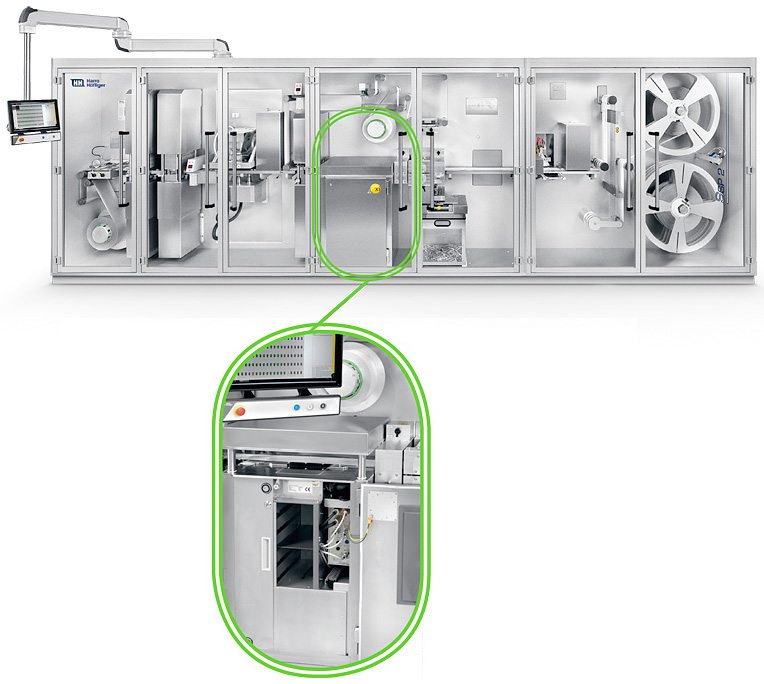Normally, the verification of powder filled blisters is done by means of destructive random sampling: An aluminum strip is removed from the process and opened in a separate test unit. If the net weight of the weighed dry powder deviates from the defined set value, the dosing process must be re-adjusted and the random test repeated afterwards. This may result in production losses and delayed batch releases.
When such OOS incidents (Out Of Specification) happen, short reaction times are crucial for pharmacists. Harro Höfliger therefore now offers an integrated X‑ray module for continuous quality control in their blister machines with membrane filling technology. An X‑ray beam penetrates the sealed powder cavity and strikes a flat panel detector, converting the intensity distribution into a digital image with a range of gray-scale gradations. Light and dark colors correlate with the respective amount of radiation energy absorbed by powder and aluminum film.

Compact and safe integration of the X‑ray module in the Blister Machine SSP2. Convenient operator control via the HMi operator panel.
If the absorption rate of the empty blister strip and the powder mass are known in the reference pattern, the software sets the gray value in relation to it. That way the system can be calibrated. For every new product with a different composition, the correlation value of fill quantity and gray value is determined and the system calibrated again. The powder mass is verified by Harro Höfliger’s IPC-checkweigher for blister strips. After programming the new coordinates, a fill quantity control with automatic trend control for the complete batch duration is possible. At the same time, seamless data recording facilitates a smooth batch release.
(Photo: Helmar Lünig)
The system reliably verifies fill quantities down to 5 milligrams and without changing machine speed. On the model SSP2 blister machine for small series, 60 to 80 cavities per cycle are inspected, at up to 15 cycles per minute. The minimal radiation intensity has no impact on the active pharmaceutical ingredient or the operator’s health. The new X‑ray technology will not only be used in future blister machines, but existing machines can also be retrofitted. Another plus: The system detects damage to the aluminum blister and detects foreign particles in the powder cavities.
X‑ray — This is how it works
Whether used for luggage control or at the doctor’s office: X‑ray images are practically a part of everyday life. Inspections and screenings benefit from the fact that the absorption of X‑rays passing through matter varies. More or less attenuated, they then strike an X‑ray film or a modern detection system, which converts the information into a digital image. The gray scales reflect the degree of absorption. Thus, our radiolucent muscles appear almost black, and the robust bones white. In addition to material density, attenuation also depends on the atomic number in the periodic table: Due to their higher number of electrons (aluminum: 13, iron: 26), metals absorb less radiation energy than organic substances (carbon: 6). A measure of attenuation is the gray-scale value. The higher it is the more rays are registered by the detector.
Download this article as PDF file
Photos: Helmar Lünig

